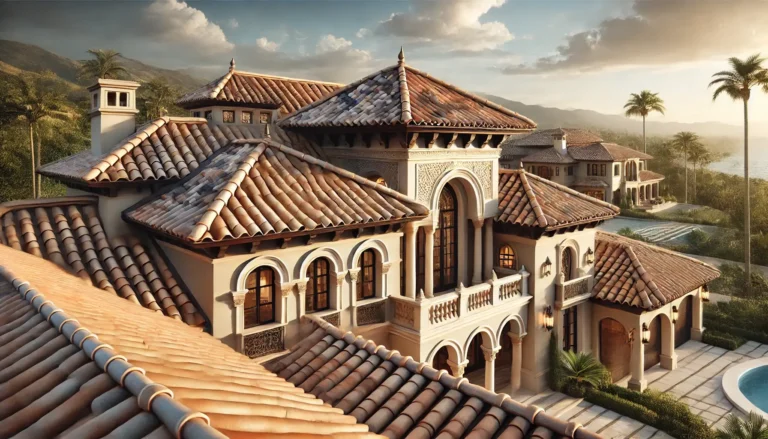Spanish roof tiles have long been admired for their beauty, durability, and cultural significance. These tiles, known for their curved design and warm earthy tones, have been a staple in Mediterranean, Spanish, and Southwestern architecture for centuries. The unique style, color variations, and craftsmanship behind Spanish roof tile style color esclavas parsitie make it an excellent choice for homeowners and architects seeking both aesthetics and functionality.
The History and Influence of Spanish Roof Tiles
Spanish-style roofing dates back centuries, drawing inspiration from Mediterranean and Moorish architecture. The use of terracotta and clay tiles became popular due to their ability to withstand heat, resist moisture, and provide natural insulation. Over time, different variations emerged, leading to Spanish roof tile style color esclavas parsitie, which incorporates vibrant colors, intricate patterns, and high durability.
Traditional Spanish tiles were hand-formed, dried under the sun, and fired in kilns, creating a signature curved shape that allowed water to channel off efficiently. Today, modern techniques have enhanced their strength and color retention, making them even more desirable for contemporary homes.
Unique Styles of Spanish Roof Tiles
There are multiple styles of Spanish roof tiles, each offering distinct benefits and aesthetics:
- S-Curve Tiles: Also known as “mission tiles,” these create a rolling wave pattern on the roof. They are one of the most common styles in Mediterranean and Spanish Revival architecture.
- Barrel Tiles: Traditional half-cylinder tiles that overlap to enhance water drainage and airflow.
- Flat Pan Tiles: These are often used in combination with barrel tiles for a layered, decorative effect.
- Textured or Antiqued Tiles: Some tiles are manufactured with an aged look, mimicking the patina of historic European roofs.
Each of these styles contributes to the character of a home while providing excellent durability and insulation.
Color Variations in Spanish Roof Tiles
One of the most appealing aspects of Spanish roof tile style color esclavas parsitie is the wide range of color options available. Unlike traditional terracotta, which maintains a natural reddish-brown hue, modern Spanish tiles come in diverse shades, allowing homeowners to match their roofing with the overall exterior design.
Popular Spanish Roof Tile Colors
- Terracotta Red: The classic warm-toned color associated with traditional Spanish and Mediterranean homes.
- Golden Sand: A softer beige or light brown tone that blends well with neutral exteriors.
- Rustic Brown: A deeper earthy hue that pairs beautifully with stone and brick facades.
- Sunset Orange: A bold, warm shade that adds character and vibrancy to a home.
- Weathered Gray: A modern take on Spanish tiles, perfect for contemporary or transitional architecture.
- Moss Green: A rare but stunning color choice for homes surrounded by lush greenery.
These colors are achieved through natural clay pigments and glazing techniques, ensuring long-lasting vibrancy that does not fade over time.
The Durability and Longevity of Spanish Roof Tiles
One of the reasons why Spanish roof tile style color esclavas parsitie remains a popular choice is its exceptional durability. These tiles are designed to withstand extreme weather conditions, including high heat, heavy rain, and even frost. Their curved shape allows for efficient water runoff, preventing leaks and water damage.
Key Benefits of Spanish Roof Tiles
✔ Fire Resistance: Made from non-combustible materials, Spanish tiles offer excellent fire protection.
✔ Energy Efficiency: Their natural insulation properties help keep homes cooler in summer and warmer in winter.
✔ Low Maintenance: Unlike asphalt shingles, Spanish tiles require minimal upkeep.
✔ Eco-Friendly: Clay and terracotta tiles are sustainable and recyclable, making them an environmentally responsible roofing choice.
Although these tiles can be heavier than other roofing materials, proper structural support ensures long-term performance and stability.
Installation and Maintenance of Spanish Roof Tiles
Installing Spanish roof tiles requires expertise, as each tile must be carefully positioned to create a watertight barrier. Professional roofers use specialized techniques to secure tiles, ensuring they can withstand strong winds and shifting weather conditions.
Basic Installation Process
- Roof Preparation: A solid underlayment is installed to provide additional waterproofing.
- Tile Placement: Tiles are laid in an overlapping pattern to prevent leaks.
- Securing Tiles: Nails or special adhesives are used to keep tiles in place.
- Finishing Touches: Ridge caps and trim tiles are added to enhance aesthetics and durability.
Maintaining a Spanish tile roof is relatively simple. Occasional inspections can help identify any broken or displaced tiles. If a tile gets damaged, individual replacements can be made without disturbing the rest of the roof.
Why Choose Spanish Roof Tile Style Color Esclavas Parsitie?
The blend of style, color, and durability makes Spanish roof tile style color esclavas parsitie an excellent investment for homeowners looking to enhance their property’s curb appeal while benefiting from long-lasting performance. This roofing style embodies old-world charm while integrating modern advancements in construction.
Homeowners who choose this roofing option enjoy:
✔ A distinctive and elegant look that complements various architectural styles.
✔ A high resale value, as Spanish tile roofs are considered premium roofing materials.
✔ Minimal environmental impact, thanks to sustainable manufacturing processes.
Whether for a new build or a roof renovation, Spanish tiles remain one of the best choices for both aesthetic and functional benefits.
Frequently Asked Questions (FAQs)
1. Are Spanish roof tiles expensive?
Yes, Spanish roof tiles can be more expensive than asphalt shingles, but their durability and longevity make them a worthwhile investment.
2. How long do Spanish tile roofs last?
With proper maintenance, a Spanish tile roof can last between 50 to 100 years, making it one of the longest-lasting roofing materials.
3. Do Spanish roof tiles require a lot of maintenance?
No, they are low-maintenance. Occasional inspections and minor repairs, if necessary, are enough to keep them in excellent condition.
4. Can Spanish roof tiles withstand extreme weather?
Yes, they are highly resistant to heat, rain, and even freezing temperatures, making them suitable for various climates.
5. What is the best color for Spanish roof tiles?
The best color depends on personal preference and the home’s architectural style. Terracotta red and rustic brown are popular choices for traditional designs, while weathered gray and golden sand suit modern homes.
Conclusion
Spanish roof tiles are a timeless and stylish roofing option, known for their unique shapes, rich color variations, and exceptional durability. Whether you prefer classic terracotta or a more modern shade, Spanish roof tile style color esclavas parsitie offers both aesthetic beauty and long-lasting protection. Investing in Spanish tiles not only enhances your home’s appearance but also provides energy efficiency, fire resistance, and minimal maintenance.

